I wasn’t very far into my real food journey the first time I heard the term “clabber.”
My initial thought was, “What the heck is that?” So I promptly headed to Google to check it out.
It’s amazing how something that was so common a hundred years ago is so unheard of today…
Clabber is basically thickened sour, raw milk. Part of the reason that we don’t use the term anymore is because store-bought, pasteurized milk doesn’t clabber. It just putrefies and turns nasty. So, clabber is definitely an old-fashioned concept for most folks.
If the word sounds familiar to you, it might be because it’s the name of a popular brand of baking powder. Back in the day, women would keep clabbered milk as a natural leavening agent for baked goods. Clabber is acidic, like buttermilk, so it reacts with baking soda to produce fluffy cakes and quick breads.
However, once baking powder was introduced, clabber wasn’t as necessary. But one manufacturer of baking powder, Hulman & Company, chose to name their product Clabber Baking Powder (Clabber Girl) to help consumers understand how to use it.
So there is your history lesson for the day. 😉
-> If you found this history lesson interesting, then old-fashioned from-scratch cooking might be for you. I get some feel they just don’t have the time or recipes to cook from scratch meals. I can help with that, this post will show you How to Cook from Scratch When You Have Limited Time, and The Prairie Homestead Cookbook has some great simple from-scratch recipes for you to start with. <-
Sour Raw Milk vs Spoiled Pasteurized Milk
As you know, I’m a big fan of raw milk for many reasons, but I especially love the fact that it doesn’t go “bad” like pasteurized milk does. Why is that?
Pasteurized milk is heated at high temperatures killing almost all the bacteria (good and bad). Without the presence of good bacteria, bad bacteria and mold are allowed to grow causing pasteurized milk to rot. The good bacteria killed by the pasteurization process are needed for raw milk to ferment (sour) and create clabber.
Fermentation is another old-fashioned technique used in the kitchen, it creates healthy, probiotic-rich foods. Fermentation is an old way of storing vegetables for an extended period of time. Some well-known things that are created by fermentation are sauerkraut and pickles.
When it comes to fermenting dairy products it is a little different than vegetable storage. Cultures and bacteria are added to milk to make things like cheese or yogurt. Raw milk already has the necessary bacteria and creates its own cultures when left to sour.
Once raw milk sours, it can still be used for a whole bunch of different things, unlike the cooked stuff which must be thrown out once it turns sour.
Souring Your Raw Milk
Souring raw milk intentionally is a very simple process. You take your unused Raw Milk out of the fridge and allow it to sit at room temperature. Depending on the age and temperature in your home in 2-5 days you should see it start to separate.
Raw milk goes through varying stages as it sours. It starts off by slowly decreasing in sweetness each day it sits in the fridge, and if you leave it long enough, it will eventually separate into curds and whey.
Soured raw milk will maintain a “pleasantly” sour taste and smell. Now, I’m not saying that you will want to drink it straight (although some folks do), but it shouldn’t make you want to throw up when you open the lid. (If it does, toss it!)
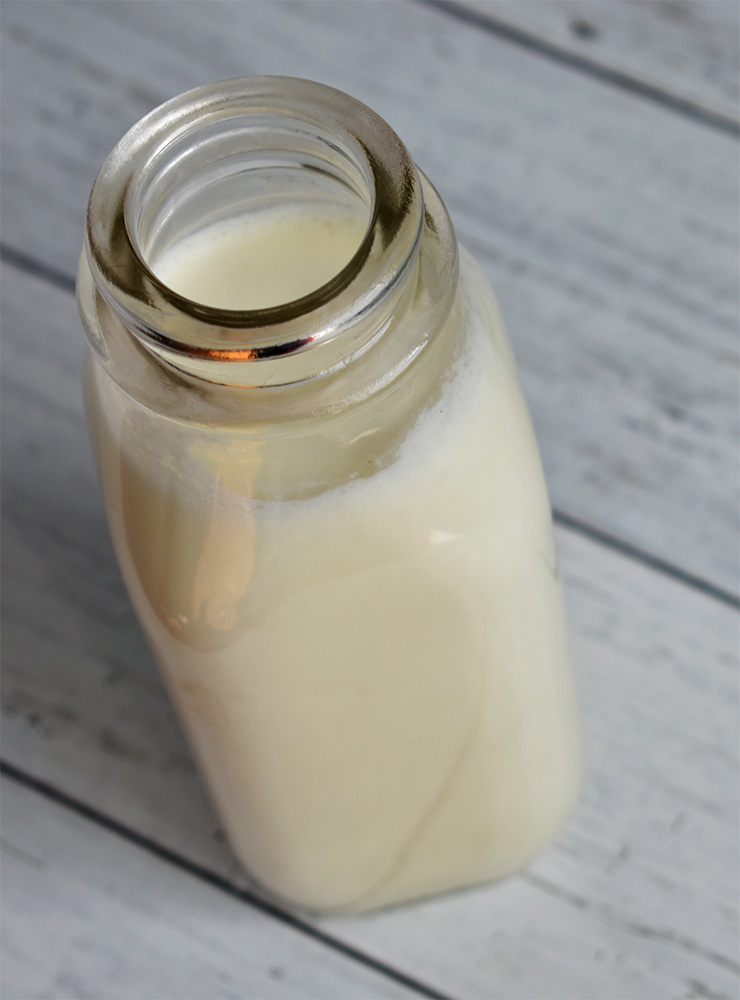
So, next time you end up with a gallon or two of clabber, don’t pour it down the drain– put it to good use instead:
**VERY IMPORTANT** The following ideas are only to be used with RAW milk that has soured. Do NOT attempt to use soured pasteurized milk– it is not the same and should be thrown away.
20 Ways to Use Sour (Raw) Milk
1. Make chocolate cake- use the clabber in place of the milk or buttermilk in the recipe.
2. Make zucchini bread or banana bread.
3. Add it to yeast breads or rolls.
4. Make delicious homemade waffles or pancakes.
5. Make muffins for breakfast or snacks.
6. Use it as a base for your smoothies.
7. Soak chicken or fish in sour milk to help tenderize the meat.
8. Use it as the base for a homemade marinade.
9. Use it to soak grains, Nourishing Traditions style.
10. Use it to make buttermilk biscuits (in place of the buttermilk).
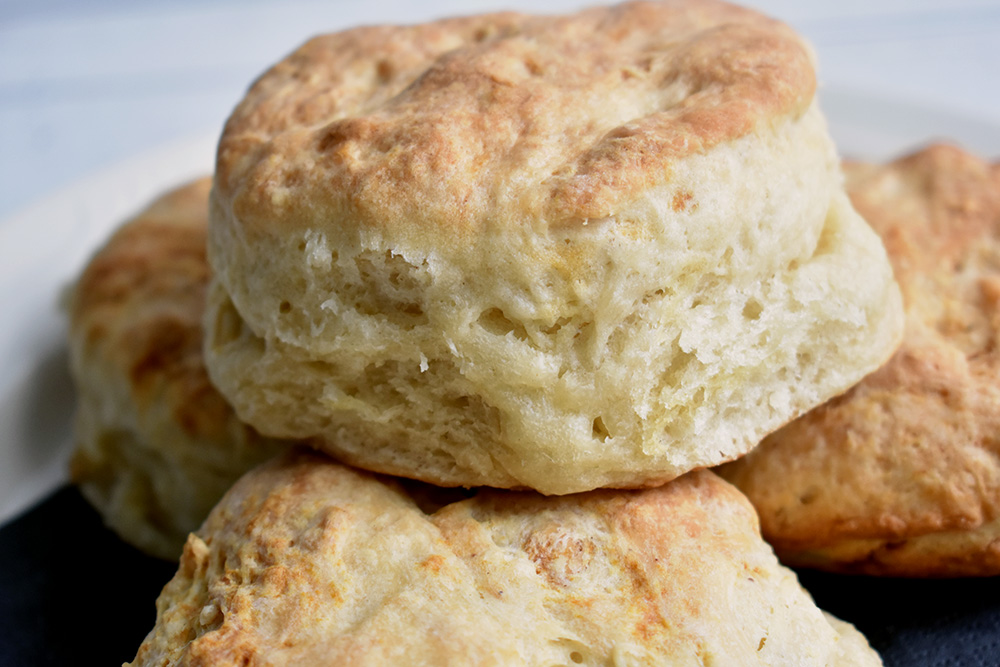
11. Add it to casseroles or soups.
12. Add a little sweetener and cocoa powder to make homemade chocolate milk. (I’d do this before it starts to really separate.)
13. Make homemade pudding.
14. Feed it to your chickens, pigs, or dogs. (It’s really good for them, too!)
15. Dilute it with water, and add to your garden.
16. Use it to make homemade milk kefir
17. Dilute it with water, and give it to your tomato plants.
18. Add it to your bath- add some essential oils if you don’t care for the smell.
19. Use it as a substitute for recipes that call for buttermilk, yogurt, or sour cream.
20. Make your own whey and clabber cheese. (And once you have your homemade whey, here are 16 Things to do with Whey)
Will You Be Using Sour Raw Milk?
Sour or fermented raw milk is great for baking, gardening and can add healthy probiotics to your diet. You can’t use store-bought pasteurized milk, but the good news is even without a milk cow you can find raw milk. In some states, it is not legal to sell raw milk, but you can join a local milk share program. A milk share program is when you buy shares of a single cow and in return receive raw milk.
Maybe the idea of using sour milk isn’t something you are ready for yet, but old-fashioned from-scratch cooking is still something you are interested in. If this sounds like you then you are a perfect match for my Heritage Cooking Crash Course.
The Heritage Cooking Crash Course was designed to simplify from scratch cooking while saving you time in the kitchen. In this course, you will find step-by-step tutorials for making breads, fermenting vegetables, and other old-fashioned cooking techniques. No special equipment or extra expenses, only simple ingredients and everyday tools.
Learn more about The Heritage Cooking Crash Course and how you can start cooking from scratch now.
Other Posts for Dairy-Lovers:
- How to Make Cream Cheese
- 16 Ways to Use Whey
- How to Make Fromage Blanc (soft cheese)
- Why We Drink Raw Milk
- The Goat 101 Series
- 6 Tips for Safely Handling Raw Milk
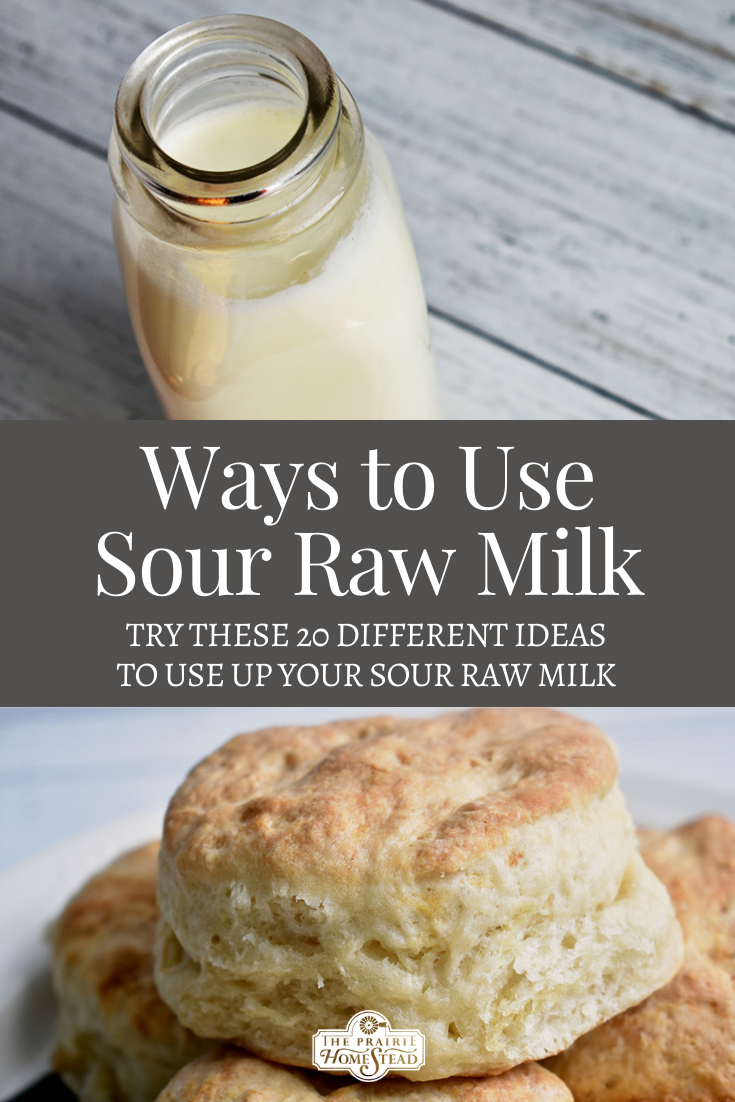
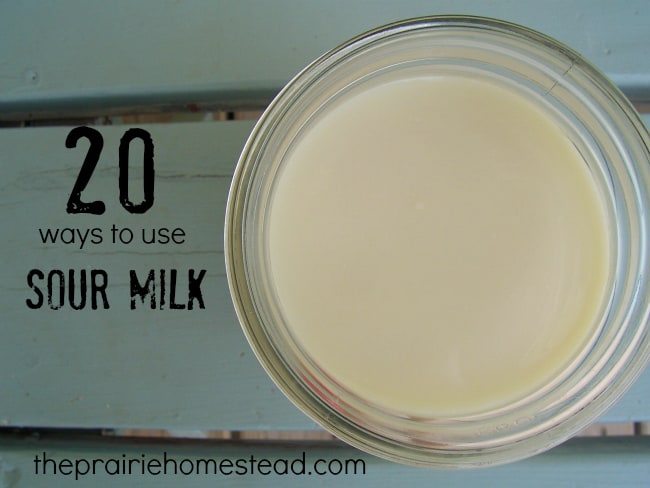



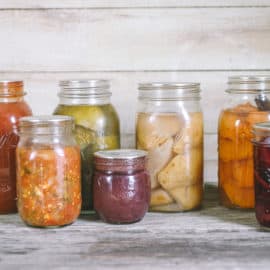
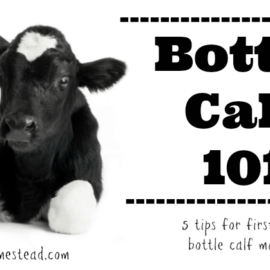
I am told that sour raw milk that is too bad to drink can be put on the garden – plants love it and bugs hate it!
yup!! I hear pumpkins like it too!?
My grandmother put the raw milk on the counter (near the woodstove) for the day before making her butter. Since she didn’t add any culture, I’m assuming that it wasn’t acutally clabbered milk. She said it makes better butter and buttermilk.
I have a question! I have some raw milk that’s 12 days old, and I read that it lasts 7-10 days. So can the souring process still be started after it has “expired” or will that change the safety of consuming it?…
Thank you for all the great info!!
I have raw milk that has set in the refrigerator for 4 weeks due to Covid. Can I still use it to make mozzarella cheese?
You can use sour raw milk to make cheese, but not spoiled milk, so make sure that is the case first. You should be able to make it, but cheese can be finicky. There are specific cheeses you can make with sour milk if you want to be 100% sure not to waste milk.
What a great post! We’re new to milking goats, so I’m sure this will come in handy. You can see our goats at ARunawayGoat.blogspot.com.
Hey I have been drinking slightly sour raw milk but today it was a bit further along it didnt smell bad but I could taste that it was souring i have a stomach ache and had a little diarrhea did I just consume bad bacteria?
You don’t ferment milk (or anything) in the fridge. Clabber is made from raw milk at room temperature…it’s astonishing how detached people have become from reality in the US. We have been eating clabber for ages in Europe, had lots as a child, and nobody would ever make it in the fridge. That’s the whole point, fermentation happens at room temperature not in cold…
Yeah, that is why fermenting at colder temperatures had been done all over the world for thousands of years.
I ignored two gallons of milk in the back of the fridge for longer than two weeks, it is very sour and I made butter with the very separated cream and the butter is soured tasting I’m just curious if it is advisable to discard it? Thanks!!!
So does this mean it’s still ok in thr fridge until you want to “clabber “ it
Hi there, I have just this afternoon made some awesome pikelets (you might call them drop scones?) for the children’s afternoon tea, as well as using soured cream and buttermilk for a lovely Ginger Bread Cake. Delicious; such good cooking!
I was wondering if you could expand on the sour pasturised milk issue, as that’s our only option in supermarkets, even though Tasmania, Australia produces wonderful milk. The best (still pasturised ) milk has has soured without being aweful to smell, so I’ve used it. Any thoughts would be appreciated.
I’ve been enjoying your blog the most out of anyones I’ve ever read, as I have really been growing in my real food journey, seeking God’s best for our children’s sustenance and our daily food habits too. Thanks so much for the time you put into it; it’s great to see your creativity and practicality. Thanks.
So happy that you’ve been enjoying the blog Amy!
When milk is pasteurized, most, if not all, of the beneficial bacteria it contains is killed. These bacteria are what allows it to sour naturally and eventually turn into curds and whey. However, if those bacteria aren’t present, the milk just ends up going rotten.
So, I supposed it would depend on what type of pasteurization your milk has had– (some milks are low-temp heated, while some in the US are Ultra Heat Treated, which basically makes them sterile). But, I’d still be very careful. 🙂
I feed clabbered milk to my chickens. I do use store milk and I put in 1/2 ice cube of frozen lemon. Sometimes I just let it sit in the shed. The smell is not any worse than smelling cottage cheeese and my chickens love it. I know you explained clabbered is a raw milk thing (I came from the farm) but this is just what happens to my store. The dogs would eat it if I let them but the chickens go nuts when it is mixed with oatmeal.
That’s not clabbered (fermented) milk, it’s curdled by the acid you add with the lemon juice. I’m glad your chickens like it, but there’s no bacteria in it – that’s why it “works” for your store bought milk.
You don’t have to add acid to store bought milk. You can add bacteria culture to store bought milk and the bacteria will still reproduce while they eat sugar and produce lactic acid, fermenting that store bought milk. Lots of people have done it, myself included.
I was just wondering this same thing! The milk I buy is non-homogenized and pasteurized at the lowest temp and shortest time allowed in our state. It tasted unpleasant but didn’t have a strong smell. Does that sound like something I could at least bake with? Thanks for your advice!
Yes, you can certainly bake with it. While we have raw milk from our goats, we have to use pasteurized milk in our coffee business. Frequently, we have leftover milk that sours, and it works great for cooking with. I just made a great cinnamon coffee cake with it.
Commercially soured milk (buttermilk), yogurt, kefir, and sour cream products are cultured/fermented after pasteurization of the milk/cream. In the US the labels often mention this fact.
In other words, the pasteurized milk is inoculated with the fermenting culture, so the cultures will still be live/active when purchased.
This is similar to the homemade yogurt process of scalding the milk first, then adding the live/active yogurt cultures after the scalded milk has cooled down to just warm temperature that won’t kill off the newly introduced cultures. Scalding the milk does indeed kill off the naturally occurring bacteria in the raw milk (and the remaining bacteria that survive commercial pasteurization* or contamination that occurs after the carton of pasteurized milk is opened), but it also reduces the field of bacterial competition for the lactose, ensuring that the yogurt bacteria not only survive, but thrive and win against the competition. That’s one reason why scalding milk (whether raw or pasteurized to begin with) produces a thicker, more predictable yogurt.
*unopened commercially pasteurized milk is not completely sterile – there are always some hardier strains of bacteria that will survive, but which is why the milk will eventually spoil in an unopened carton.
Ultra-pasteurized milk, which is increasingly common in commercial organic milk and cream products (sometimes it’s the only form available) is heated to higher temperatures and for longer than simply pasteurized milk. It has a cooked flavor. Fewer spoilage bacteria remain, so the unopened “shelf-life” is much longer than for simply pasteurized milk, which makes ultra-pasteurized milk and cream far more profitable, allowing for huge commercial dairy brands to ship milk very long distances.
UHT milk in the tetra-boxes is heated to extremely high temperatures which sterilizes the milk so it doesn’t “spoil”, even at room temperature. The taste is very “cooked” and very different than truly fresh milk.
I’ve left some raw milk on the counter in a glass jar covered with a dish towel to make whey and curds. But now the top has some mold or fungus on it – doesn’t smell bad kind of smells like cheese. Is it bad? Should I throw it out? Please help. Thank you.
I’ve just gotten a yogurt starter from cultures for health; is it ok to use clabber to make my yogurt? Just the slightly sour kind, not the completely separated kind. I was so glad to see this post in my mailbox this morning because my husband and I have been getting raw milk for the past few months, and it has happened more often than I like that the milk turns before we can drink it and I’ve been so frustrated at dumping it for lack of knowledge as to how to use it!
It should be just fine to use your slightly soured milk to make yogurt. 🙂
If your raw milk is going sour fast it may not be really healthy milk from healthy cows. I milk my own cows and the milk has been still drinkable after 6 weeks. I do store it in glass which makes a huge difference. Maybe you could put into glass when you get it.
I agree Lucy and I’m curious about my raw goat milk that basically keeps for weeks and then I’ve had a random jar go sour 2 random times!?! Even if another jar from the same day doesn’t! I generally don’t have the space to keep milk around for long but sometimes as occasional jar gets pushed to the back in rotation and it will smell like it was milked yesterday!
The only thing I could think of is that that odd jar is not quite clean – maybe just a tiny bit around the rim, or even not quite dry enough. I wash my bottles in hot soapy water, rinse REALLY well and then place in the oven to dry – just on about 100C. I put the lids on when they are completely dry to keep them clean. If the lid is not quite dry enough, the bottle will sweat a bit, so I know that I need to re-wash! I think if you are storing raw milk, cleanliness is so important! And I agree, my milk doesn’t usually last long enough to go off!
Oohhhhhhhhhh. I’ve been getting raw milk for the past year from s local farmer and our milk usually starts turning after 7 or 8 days. BUT, while I clean the glass jars we store the milk in, I don’t put much effort into really sanitizing them. I just do a quick wash or a run through the dishwasher. Hmmmm. I wonder if that’s why it doesn’t last longer. I’m also guilty of occasionally drinking the milk straight from the jar. I hadn’t considered that it’d make it turn faster, but I’m sure that also contributes. I just thought it was normal for raw milk to only taste fresh for 1 week. I have so much to learn, haha.
I’m loving all these things you’re posting about raw milk. Keep ’em coming!
I am so glad to learn that I don’t have to worry about wasting my raw milk as it gets down to the bottom of the jar and gets a little sour! These ideas are great to know. I am wondering if it can be frozen for later use, or if freezing reduces the leavening effect?
Yes, you can definitely freeze it! (And I need to add that to the list!) 🙂
Wonderful! I just froze some in ice trays so I can store the cubes for later use in recipes. I found that 7 cubes = approx one cup milk in my trays.
Yay! Thanks for all the wonderful information. I really look forward to it!
I’m so glad to find this post! I’ve dumped one gallon of our raw goat milk because I didn’t get it strained and frozen for a couple of weeks and I hated doing it. Been thinking of making yogurt, which means I need to collect a good bit of milk, hence the delay, but never find the time to just do it. Now I know I can use my older milk and slightly soured milk in it. Yay!!
I have enjoyed reading your blog more than any others! These tips are great and I was completely ignorant of them before finding your blog. I can’t wait until I can start using them! I’m also writing about my journey as I learn new things for homemaking and homesteading on Natural Made Simple. I just started it so any tips you may have would be great! Thanks!
Congrats on your new blog! My best tips for bloggers are to network, network, network! And write posts that are easy for people to use and share. 🙂
How long does it take to have your milk turn into clabber? I have drank raw milk my entire 40 years and didn’t know about this! Interesting. A gallon of milk only lasts a day at our house – so would have to hide some milk to make clabber!
If you leave it out on the counter, it usually takes 2-3 days to clabber.
Definitely making me yearn for my dairy farming days and always using our own raw, unpasteurized, homogenization milk from cows fed organically.
I was also wondering how long it took to clabber in the Frigerator and then how long will it last after it clabbered. Funny we have been milkingcows and goats and we have turkeys and chickens that drink the left over milk. We let that milk clabber before giving it to them. We leave it outside to do that. Never thought I could let it clabber in the frig and use it. Love this…I didn’t know that we were clabbering after all. Thanks for all the raw milk information!
It really depends– sometimes it takes about 10 days in the fridge, and sometimes a lot longer! Leaving it on the counter is definitely the easiest way if you are in a hurry.
Can You make keifer from sour raw milk & how do You make the seed’s for keifer????
My Grandma taught me about clabbered milk. I do it just the way our family used to do it in the old days except I use a low temp oven instead of the warming rack of a cook stove. I keep the milk around 100 degrees and in about 24-36 it is separated. Then I strain it and we love it spread on our homemade bread. It is also good added to sauteed onions; just add it to your helping and mix it in. Sometimes we sweeten it with honey or mix in some herbs. We love it!
Yum! I love that your Grandma passed down her knowledge. 🙂
Growing up my mother made clabbered milk we referred to as cottage cheese. Spent every evening shaking our jars of cream to see who could create our little ball of butter first. What good food we had!!
Where can a person find raw milk.? I was raised on raw milk in Virginia. I now live in Colorado & can’t seem to find it anywhere. I would love to be able to buy it & make my own cheese, butter, ect. like my grand ma did when I was a child.
You can go to the Real Milk Campaign’s website and find it locally.
http://www.realmilk.com/real-milk-finder/
You have to own a milk share to get raw milk legally in CO. I often find posts on Craig’s list when people have shares to sell.
Good information! I own a share and we love the milk!
I froze my slightly soured raw milk in ice cube trays & then used it to make home-made soap! It’s still curing, but I’m very excited to try it as it feels quite luxurious! I still have some in the freezer, I might use it in soap or maybe I’ll try one of the suggestions here. Thanks for all the great tips. My family is new to raw milk & my boys are having varied reactions to the change in milk (from pretty laid back & accepting to running out & buying “regular” 2%) so I always worry that it might go to waste. They are 16 yrs and up, so, they really can’t be pushed too much either way. I’m confident they’ll eventually adjust & enjoy!
Hi, was wondering if you could give me some insight… I have some soured milk in my fridge that I was hoping to use, but when I took it out there is a brownish residue on top the cream layer. The glass bottle it is in has a very narrow neck so it is difficult for me get a really close look. Could something be growing on it? It was at the back of my fridge, which is usually cold enough to freeze whatever I put back there, so I don’t understand how that would happen. Everything I read about raw milk says it doesn’t go “bad”, so what happened?
Thanks for any info you can offer
What does it smell like? A sour smell is ok– a putrid smell that makes you run for the toilet is not. 😉 Sometimes when my milk becomes really, really sour, it’ll separate and the whey on top will be slightly brownish. Usually when it gets to that point, I usually give it to my chickens. But, that’s not to say you couldn’t use it.
Irene I read that is completely normal ecspecially if it smells and tastes good
Hi! Great, helpful article. We’d love you to come share it on From the Farm Blog Hop since it would fit right in. We are regularly getting close to 300 articles shared a week. Hope to see you there!
http://myhealthygreenfamily.com/blog/wordpress/from-the-farm-blog-hop-36/
Sandra Beaudry:
http://www.realmilk.com/real-milk-finder/
http://www.westonaprice.org/local-chapters/finding-nutrient-dense-foods
Would these ideas also apply to (quite a bit of) skimmed cream that you *ahem* left unattended in the refrigerator for 2-3 weeks???? (We had sickness and other issues that interrupted by butter making schedule.) It tasted so different than my cultured cream I use for butter. Good? Bad? Give it to the pigs?
Yes– you should still be able to use it, as long as it doesn’t smell putrid. 🙂
Exactly the article I needed today! Thanks!
Hi. I found my bag of raw curdled milk (lots going on and I forgot all about it) in the fridge. It is at least 2 months old,,,maybe longer. I want to know if it should just be thrown out or is it still okay to use for something. Thanks for your help
If it smells ok and doesn’t have mold growing on it, you can probably still use it for baking/cooking–as long as you can handle the strong flavor. 🙂
My mother has always used sour goat milk to help “eat” her septic waste. The bacteria that is in sour milk is supposed to be better than any store bought products (according to mom).
Interesting! I’ve never thought of that before!
Once you have clabbered the milk… how do you store it for use? And do you separate the clabbered milk from the whey (that is the watery substance correct?) I am all new to this but love that my raw milk doesn’t have to go to waste! Great post!
I store mine in my fridge– you can separate the curds, if you wish (some folks even make a sort of cheese out of it), or you can leave it all together. 🙂
Gee, Jill. All this is starting to come together. We’ve been drinking raw goat/cow milk, as well as the yogurt, keifer, and cheese. Recently learned how to make my own keifer, and now with your post, can take it a step further for clabbered milk. Thanks so much for all your helpful posts!
How do I make keifer from the clabbered milk?
BYW, I’m in Wyoming also and very thankful for the Food Freedom Bill!
How do you get past the smell? Soured milk and butter stink. My kids won’t touch it, especially if it is heated or put on warm toast. Even our cornbread made with raw soured milk has quite an odor to it!
Try using baking soda as your leavening agent. It will take away (neutralize) some of the sour smell and flavor. Hope this helps.
Andrea
I am raising 14 heritage Berkshire hogs and found an article about feeding expired milk to hogs as a supplement to feed. With a bit of persistence, I succeeded in finding a great source – and they love it!! Yeah for raw milk. Now that I have this article, I have more uses.
Yes– when we raised pigs last year, they went NUTS for our extra milk and whey! 🙂
Hi. I ran across your blog because I have a larger quantity of sour milk than I usually get, so I wanted to cook with it. I usually just use it on my cereal. In the State of Ohio it is illegal to sell Raw Milk but our co-op sells local gently pasteurized non-homogenized milk in returnable glass bottles. Because it is not homogenized the cream separates out and it will sour. Sometimes the cream just separates out but sometimes it does what you call clabber. So I learned something new. The milk I have now is clabbered, which is odd on cereal. So I am thinking maybe it is whether it is homogenized or not, that is more important than whether it is pasteurized or perhaps what kind of pasteurization. I have been using sour milk from this company for years with no ill effects.
Thank you so much for your website, as it is so helpful to know what to do with the raw milk I get from my local farmer.
I want to make pudding, tapioca or chocolate and I do not want to boil the milk to destroy the good bacteria. Is there a way to make it without boiling? Or is that a bad thing in the first place? Maybe boil just enough with the tapioca and add the raw milk? Up to what temp can I bring the milk, before the good bacteria is destroyed?
You are so kind to help all of us amateur cooks.
Bless you
I, too, am very curious how to accomplish these things without hearing the milk to the point of destroying the helpful bacteria…
I feed clabbered milk to my chickens for almost a year now. They LOVE it! A month ago I decided to clabber what was left after we separated the milk, hoping to use a ‘waste product’ rather than the whole milk. The curds get very spongy, literally rubbery – unlike the soft curds when I clabber whole milk. I added 1/3 of a gallon of whole milk to 3 gals of separated milk – thinking maybe there was not enough cream for soft curds – I get more curds, but the texture is still pretty rubbery. Any ideas on why the curds are rubbery, & am I creating a product that is not good for my chickens. I have never seen discussion on this subject of clabbering separated milk, hoping someone has run across this & figured it out. 🙂
My hens love clabber too! Sometimes my curds are more rubbery than others–but I think they are probably just fine. I’ve clabbered skimmed milk many times.
I am new to this blog. Do you have suggestions on where to buy raw milk?
My grandparents had a dairy farm and my grandmother used to set out shallow plates of milk in the dairy (just off the kitchen) to clabber. We would each have our own plate at breakfast to eat….sprinkled with sugar to taste. Clabbered milk is not sour tasting, nor does it taste like yogurt. It is wonderful stuff.
What an awesome memory!
Jill, was searching for “sour milk curds and whey in refrigerator” and found your blog! I’m in Burbank, California, so there are local places with two brands of raw milk: Organic Pastures and Claravale Farms. I’ve used both for various things. Right now I’ve been using OP raw whole milk to make kefir with kefir grains. After a couple of years I’ve got the kefir drill down. The results are almost always thick, creamy and awesome! I use a gallon of milk to make 4-24 oz jars of kefir. This leaves enough milk left over to feed the grains once they’ve been strained, with about a pint left over still. I always transfer the unused milk to the best size jar and tight lid to leave as little air space as possible. When the large jar gets used for the newly strained grains, what’s left goes into a smaller jar to minimize air. Sometimes that milk gets drunk, other times, not. Right now, I’ve left the 16 oz jar of milk in the fridge for about 10 days and it has fully separated. But as much as I love kefir (even very ripe kefir) and raw homemade buttermilk, the smell of the raw separated milk is not pleasing to me. It smells pretty rank. Now, letting raw milk separate at room temp in 24-48 hours doesn’t smell like that. I’ve done that before and made real cream cheese that way (a la Nourishing Traditions). So why doesn’t the “cold separated” raw milk smell like that?
Thanks for your response…
Best, RMT
I learned something New today. thanks Jill!
I am new to raw milk. Finally found a location locally that sells it. But….
I was worried that after a week it wouldn’t last much longer, so I gave 5 quarts to my friend (whose husband grew up drinking milk from a local dairy) thinking they’d down it quickly.
She said the day after I gave it to her (8 days old), it turned and she tossed it ;( 5 whole quarts, at $8.50 per gallon! O.o
Anyway, I have 3.5 half gallons still in my fridge from this last pickup because I caught a virus and wasn’t feeling well enough to make yogurt and soft cheeses (I don’t have a cheese press yet).
I actually called today and canceled my name on the pickup list because I was concerned we wouldn’t get through it fast enough 🙁 And I definitely didn’t want to toss $8.50 per gallon raw milk down the drain!
I think I may have found a source of pasteurized cream finally (not ultrapasteurized), and my local Costco has pasteurized (not ultra) milk.
My question is: can I make cheese and butter and the like from just plain pasteurized milk and plain pasteurized cream? Raw milk was costing me $135 per month, so until we get a cow I am wondering if I can conduct home dairying without raw milk for less cost (so we can save up for property to have our own cow).
Thanks!
Hi, I don’t bake or eat cereal or have pets to feed my soured raw milk to, but I was wondering if I can still drink it??!! Hah, I know that sounds off, and the taste is definitely sour, but is bad for me? Seems like it should be even healthier. Lactic acid more probiotics..? I’m drinking some now. I’ll see how I feel. My stomach is feeling weird, like it doesn’t want to eat anything else. I also ate some salad and cheese and salami. But, I’ll just take it slow and see what happens. I’m sure its fine, I’m sure its been done a billion times in old days.
Hi, I buy raw sheep milk and leave it out on the counter for couple of days, then just add to it fresh milk when is an inch stays in the bottom. I use to be constipated before consuming raw kefir but not anymore. Actually stronger is the acid cleanse out better the intestine.
It’s too bad you ruined this great information with your unfounded bias. The ONLY difference between raw and pasteurized milk is the latter is heated before sale to destroy unsafe bacteria that can be present in raw milk.
So…your list of uses for old milk is perfectly valid regardless of if you decide to drink raw or pasteurized milk!
Now, as far as taste and freshness goes, I’m with you hands down. Milk straight from the cow, picked up from a farmer who takes good care of their milk cows, is so much better! But let’s face it, most people don’t have access to safe sources of raw milk.
You are very wrong. Unpasteurized milk naturally has lactobacillus in it, along with enzimes, so when it’s left st room temperature it ferments and turns into clabber. Pasturized milj on the other hand has no lactobacillus in it, neither enzimes, and basically gets contaminated by whatever opportunistic bacteria is present in the environment and rots. I dare you leave a cup of pasturized milk on the counter for 2 days and drink it with a straight face!
My grandmother put the raw milk on the counter (near the woodstove) for the day before making her butter. Since she didn’t add any culture, I’m assuming that it wasn’t acutally clabbered milk. She said it makes better butter and buttermilk.
I ended up having to use sour cream in place of the buttermilk because I broke my jar of raw milk right as I was going to make these! Almost gave up and didn’t make them, but, after seeing my sons disappointed face, I went ahead used to sour cream and they are absolutely the best biscuits I’ve made. Thank you for this recipe?
Hi do you have ways to use raw cream that has soured in the fridge?
Hi, I mixed raw milk that was going sour with raw kefir and left it on the counter. Is this okay? I read on Healthy Home Economist’s blog that this is “One step Beginner’s Kefir”. She uses commercial kefir though which is why I’m concerned if this is going to work. Any advice would be appreciated.
You can make kefir with raw slightly soured milk, however, it will alter the taste so I suggest making a smaller batch to see if you like the taste.
I have raw milk that’s been in the frig for over a month that has started to separate. It smells sour but any fermentation is slowed when in the frig (thinking of my pizza dough recipes). Is this safe for baking or giving to chickens and pigs? Thank you!
Does this work with sheep’s milk?
While sheep’s milk is different than cow’s milk, most of these tips should still work for you.